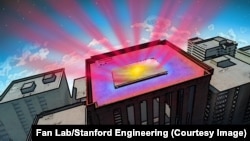Researchers have invented a material that can draw heat out of buildings and send it, along with the sun’s radiating warmth, into the coldness of outer space.
The revolutionary product, which can cool buildings even on hot days, can be fashioned into ultrathin, multilayered sheets that could be installed on a roof like solar panels. But instead of turning sunlight into energy, the sheets turn heat into invisible light and beam it away as infrared radiation.
Stanford University electrical engineering professor Shanhui Fan said the panels — which include a layer of material similar to what is found in sand — act like a kind of high-tech mirror, both siphoning heat out of the buildings and reflecting the sun's rays, sending both 100 kilometers up into the coldness of space.
No electricity needed
"It's a structure that cools itself without electricity input, even under the sun," Fan said. "So, what it does is basically radiate heat to outer space and also reflect the sunlight so it [the building] doesn't get heated up by the sun. And the net result is you get something that if you put on the roof, you have a temperature below ambient air temperature by a significant amount."
The panels, which are cool to the touch even in the sun, can reduce indoor temperatures to nearly 5 degrees Celsius below the temperature outside. And when the heat is sent into space, it is transmitted at a frequency that allows it to pass through the atmosphere without warming the air. It's almost, Fan said, like having a window into space.
He said one possible use for the panels would be in buildings with no access to electricity or air conditioning in developing countries.
“In areas where one is off-grid, this actually gave a ... significant potential benefit for storing medicine or food," Fan said. "In many of these situations, being able to reduce the temperature is important. And this would be a way to do it."
Cooling spray
The Stanford researchers, who described the technology on a small scale in the journal Nature, said the main challenge is engineering actual cooling systems using the high-tech panels. One possibility is formulating a cooling spray that could be applied to existing solid structures. They believe the technology could be scaled up in the next three to five years.
Researchers note that as much as 15 percent of the energy used in the United States is spent powering air-conditioning systems. That's money that could be saved in the long run after the initial cost of outfitting buildings with the cooling material.








